Garden Border Ideas
by: Dale Cox
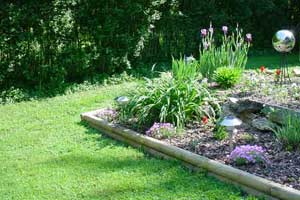
There are lots of choices for making borders and edges around flower beds, gardens and other areas of your yard. Anything from rocks to logs will work. However, creating a tasteful, attractive border may take some searching and a bit of an investment.
Take a look at any home store website or flyer in the summertime and you will likely see a number of choices for garden borders. Landscape timbers are a ubiquitous option and can make a quick, easy border without a lot of expense.
Bricks

Contoured bricks are a popular and relatively inexpensive option at about $2 each. These bricks are usually a foot long and made with some type of arched design along the top and interlocking shapes on the ends to join them together. The effect is to create a seamless "wall" around a garden space. Unless your yard is perfectly flat, you will need to work the ground a bit where you want to set these bricks so they sit level with each other and don't look disjointed or uneven when you're done.
These brick borders have become almost a cliche with many yards in a neighborhood having the same design and none being very original or unique. One way to be a bit different with these borders and give them a more refined appearance as well is to lay the bricks on their sides with the arches pointing out and stacking them two or three high. Staggering the arches on each brick so they overlap the spaces between those below can make these look more like a solid brick wall too.
Rocks
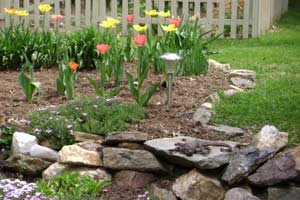
Rocks are a natural border material that has been used by homeowners since anyone ever imagined putting decorative edging around their garden. Quartz rocks are a particularly good choice for this purpose with their bright colors and reflective surface. There are also lots of naturally flat rocks that are easy to stack into a wall. If you live in a rural area, there may be a few options for getting flat rocks and some very handsome quartz for free. Many farmers have to remove these rocks from their fields to allow for planting and they usually dump them all in one place near a road or other accessible location.
If free rocks aren't an option, there are suppliers near most populated areas carrying many varieties of rocks just for those looking for this border material. While they aren't usually very cheap, the choices of rock types, sizes, and shapes can make planning a border design easier than the random selection you'll get from free sources.
Building a rock border wall can be a bit tricky, especially if you're using irregular stone like quartz. The unpredictable shapes don't usually fit together easily and the stability of the finished wall can be precarious if one or two rocks aren't stable. This is less of a problem with flat rocks but if you need to improve stability, you can use mortar to hold everything together. Black landscape-grade spray foam also works well to build a more sturdy rock border and the dark color can be visually imperceptible between the rocks.
Flexible Forms
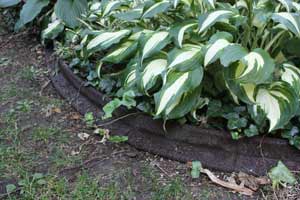
A newer option for borders and edging around the yard known as an eco-border is made using shredded rubber from recycled tires. These come in several colors and are made to be staked to the ground and joined together end-to-end with plastic dowels.
The design creates a seamless border that's flexible and can be shaped into just about any contour needed to follow the edge of gardens or other spaces in the yard. These borders are great for ringing trees and similar small areas, as well as an entire garden space. The low profile design makes it possible to mow right up to the edge, eliminating the need to run a grass trimmer after lawn mowing.
Interlocking Stone
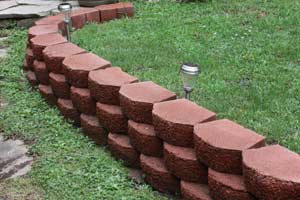
Interlocking stone and brick made for building retaining walls also make a great border for larger yards and areas with different elevations. You can stack these several layers high without the need for mortar to hold them together. A lip is formed on the back of each stone to catch the back of the stones below creating a receding profile with each layer. These stones are typically available in two sizes: 8 and 12 inches long by 3 and 4 inches high. Because of the size, interlocking stones like this are well suited for large spaces but may overwhelm a smaller garden.
Root Barriers
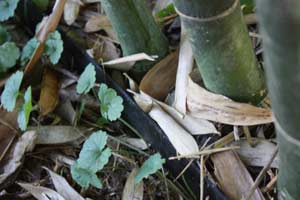
Sometimes you just need to contain aggressive plants like bamboo and ornamental grasses without concern for appearance. The roots from these and other such plants can spread alarmingly fast and far. This can create a problem if they cross your property line and spread to your neighbor's yard or public land. Bamboo, in particular is extremely difficult to get rid of once it takes hold. This can be destructive to yards and gardens as well as infrastructure like plumbing and sewer drainage lines.
Polypropylene root barriers have proven very effective at containing bamboo and other such aggressive plants. This is a sheet of plastic typically 40mil or 60mil thick and 24 or 28 inches wide. Lengths from 10ft to 100ft are available. A trench must be dug around the plant area to bury the plastic to a depth that allows a few inches to remain above the ground after backfilling. This arrangement contains the roots and prevents the plants from jumping the barrier and escaping to the wider ground. The ends of the barrier must be overlapped by a few feet and securely sealed together to prevent roots finding their way between the seam. Sealing is done with a two-sided adhesive strip that must be installed properly so it sticks fast along the whole width of the polypropylene on both ends of the overlap as any gap will be exploited by the aggressive roots in short order.
Rock Garden Borders

Some areas of the yard can be quite inhospitable to growing things. Areas where there's a lot of concrete or asphalt, and where the sun is relentless day in and day out can make growing anything nearly impossible. For areas like this, a rock garden contained with interlocking stones can add a bit of class to the area and create a maintenance free border at the same time. Adding some yard sculptures or potted plants to the mix can enhance the view even more.
 Building a Backyard Arbor
Building a Backyard Arbor